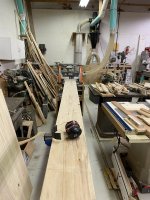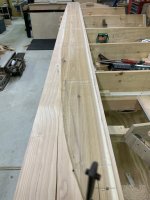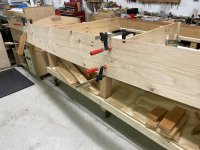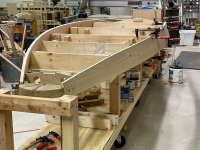After setting up the molds, the transom and the bow piece it is time to add the side planks. The plans call for using 3/4" by 8" wide by 12' long planks. My first attempt was to try to use Western Red Cedar boards from Lowes. At 7" wide they were too narrow to fit successfully. I contacted a few local sawmills that advertised cypress planks but they were out of stock.
What I wound up doing was buying 2- 2x10x12 boards in the clearest close to quartersawn as I could. I then planed the boards down to 3/4" thickness.
I clamped plank over the frames and marked the mold locations top and bottom. I removed the plank and using a batten I marked the outline of the plank. Using a jig saw I cut the plank to shape. Using the first plank and a template, trace the outline on to the other plank and cut to shape. I choose to leave the planks rough and will finish shaping after the ribs are installed.
Returning the planks to the mold. I drilled, counter sunk and installed 2 - 1/4" x 3" carriage bolts to attach the side plank to the bow peice. I bedded the plank in Dolphinite at the bow. The plans call for springing the planks from the stern to the bow. I found it easier to bolt the plank. Support the plank with a pair of clamps to avoid damaging the bow connection and springing the planks to the stern. The planks were long enough to overhang the stern and the curve is not as severe at the stern as at the bow.
Once fitted, I marked and drilled the connection at the stern, bedded the plank in Dolpinite and attached the plank with 3 screws per side to the rear.
What I wound up doing was buying 2- 2x10x12 boards in the clearest close to quartersawn as I could. I then planed the boards down to 3/4" thickness.
I clamped plank over the frames and marked the mold locations top and bottom. I removed the plank and using a batten I marked the outline of the plank. Using a jig saw I cut the plank to shape. Using the first plank and a template, trace the outline on to the other plank and cut to shape. I choose to leave the planks rough and will finish shaping after the ribs are installed.
Returning the planks to the mold. I drilled, counter sunk and installed 2 - 1/4" x 3" carriage bolts to attach the side plank to the bow peice. I bedded the plank in Dolphinite at the bow. The plans call for springing the planks from the stern to the bow. I found it easier to bolt the plank. Support the plank with a pair of clamps to avoid damaging the bow connection and springing the planks to the stern. The planks were long enough to overhang the stern and the curve is not as severe at the stern as at the bow.
Once fitted, I marked and drilled the connection at the stern, bedded the plank in Dolpinite and attached the plank with 3 screws per side to the rear.






Treated SYP is so wet I would worry about how it dries out under a layer of fiberglass.
The wood seems to be fir. Not an ideal boatbuilding wood but I came to conclusion based on several factors.
1. Duckboats are utility boats. This will probably have a life span of 10 years.
2. This is a trailer boat and will spend more time on a trailer then in the water.
3. At $8 per board foot it didn’t make sense for cost to buy the cypress.l could find.
4. I wanted to present options to someone who has limited access to traditional materials.
5. This will be epoxy and fiberglassed. The wood is more of a core.
Plus this is a learning experience and I can build another.
I appreciate the questions. I have been giving it a lot of thought myself.
Rick